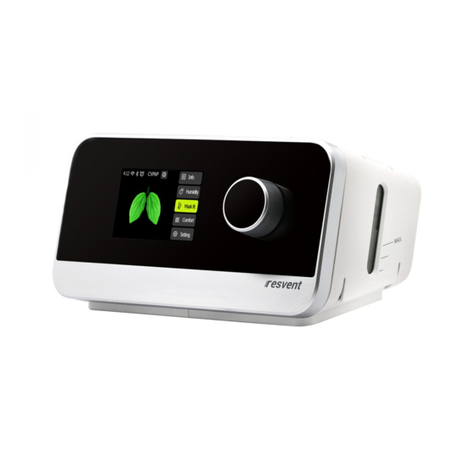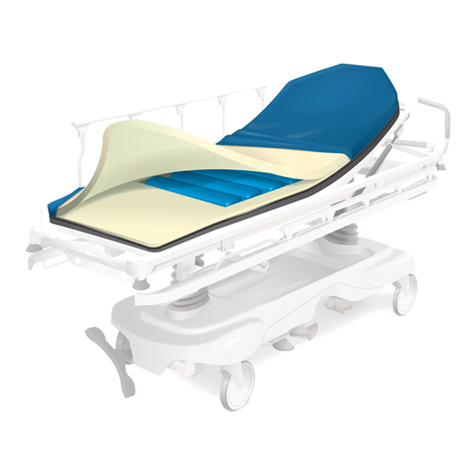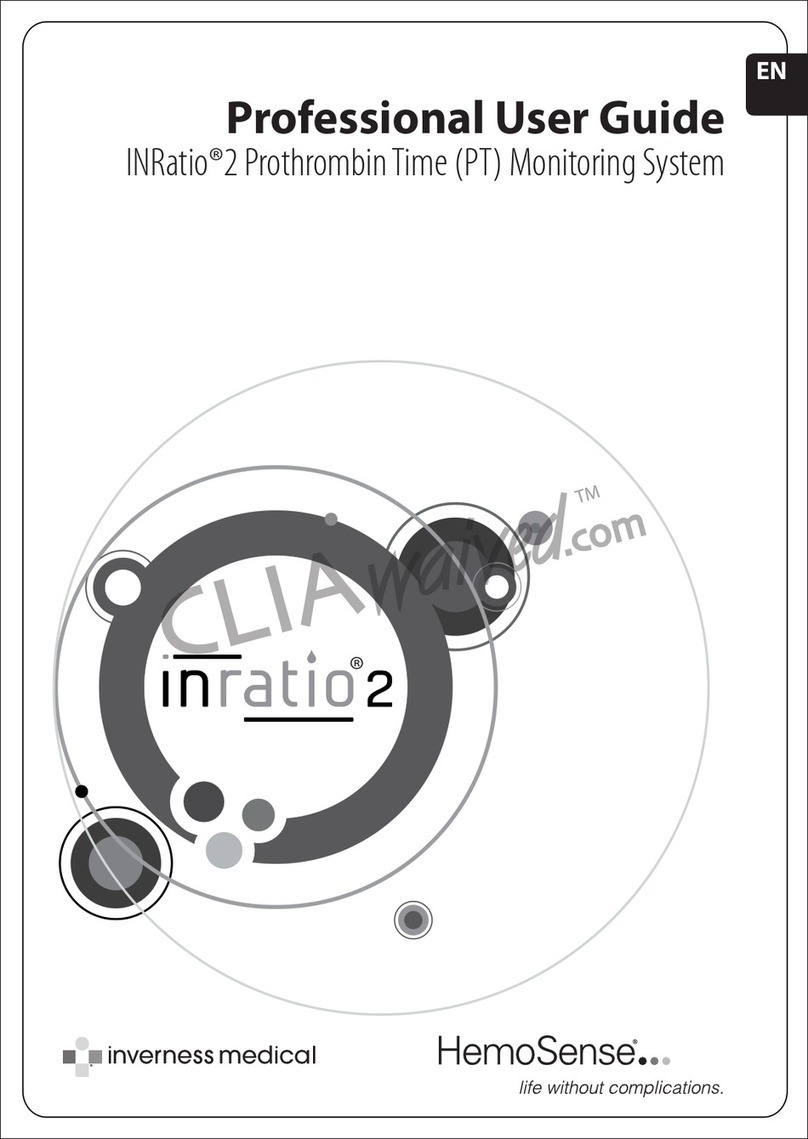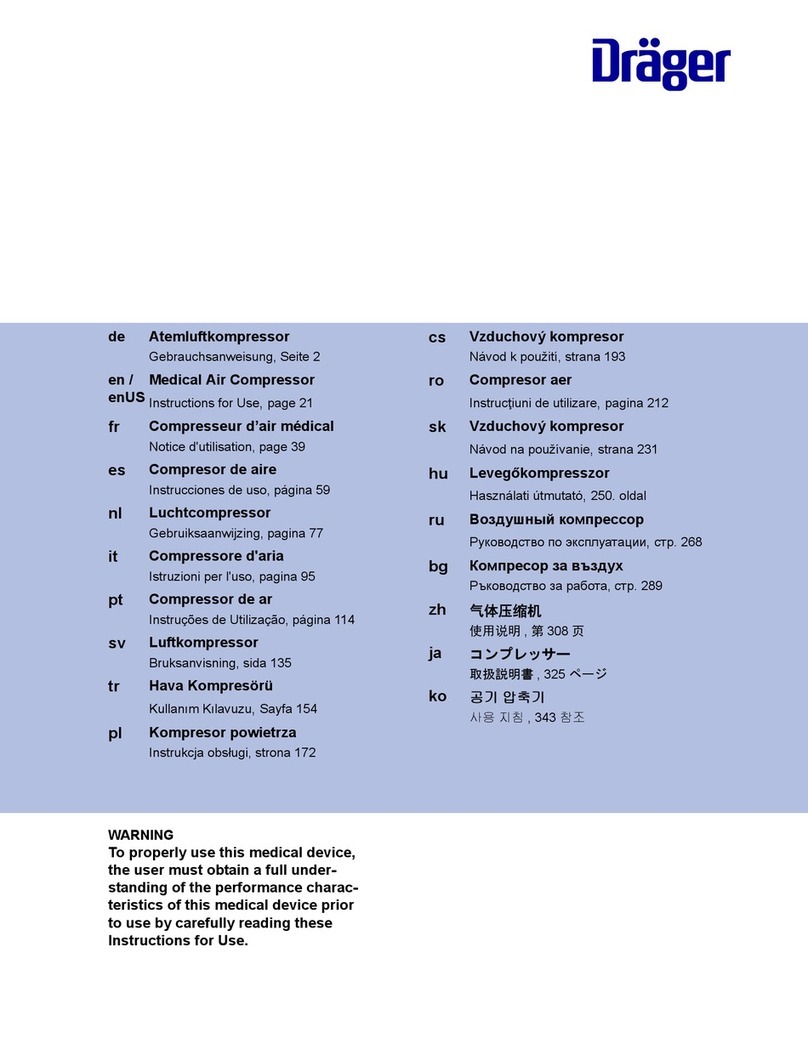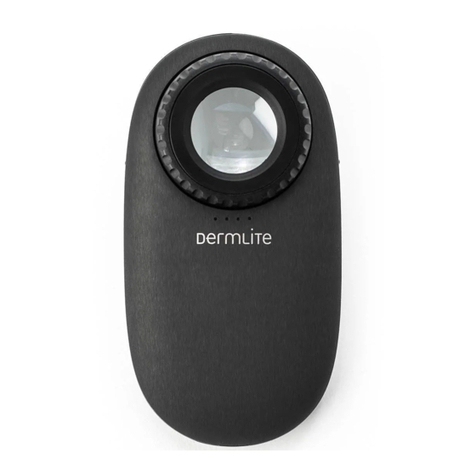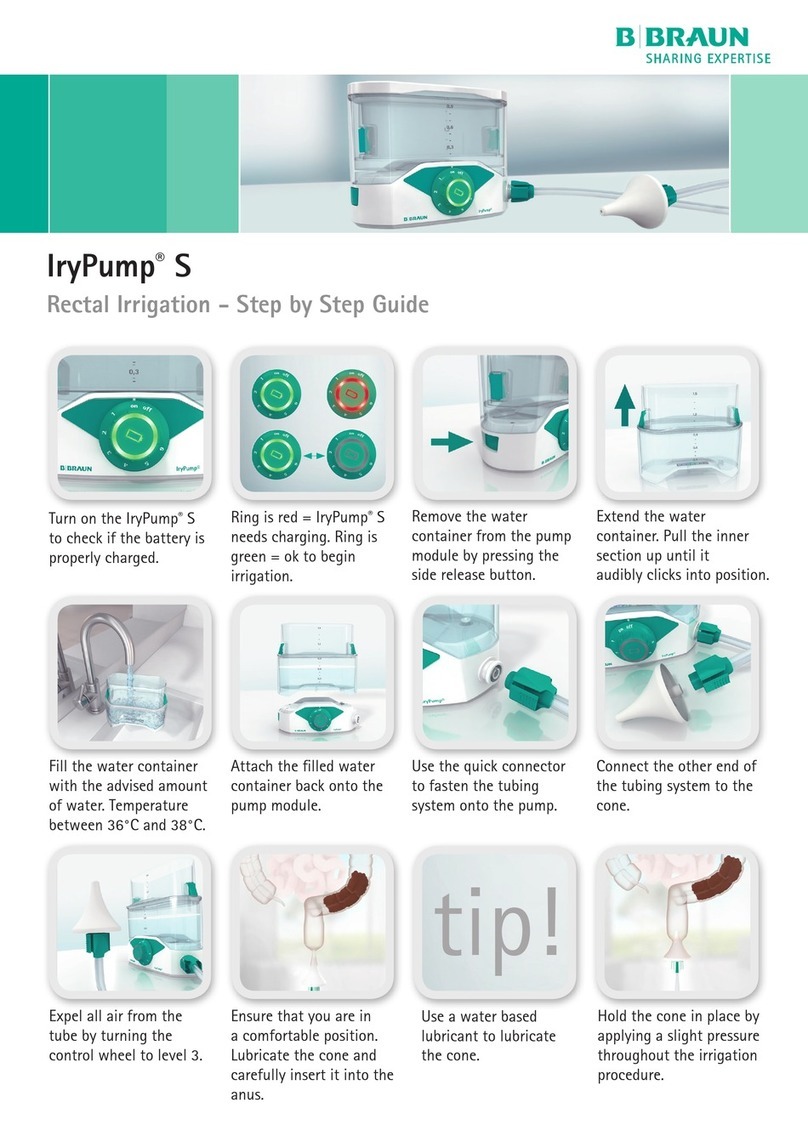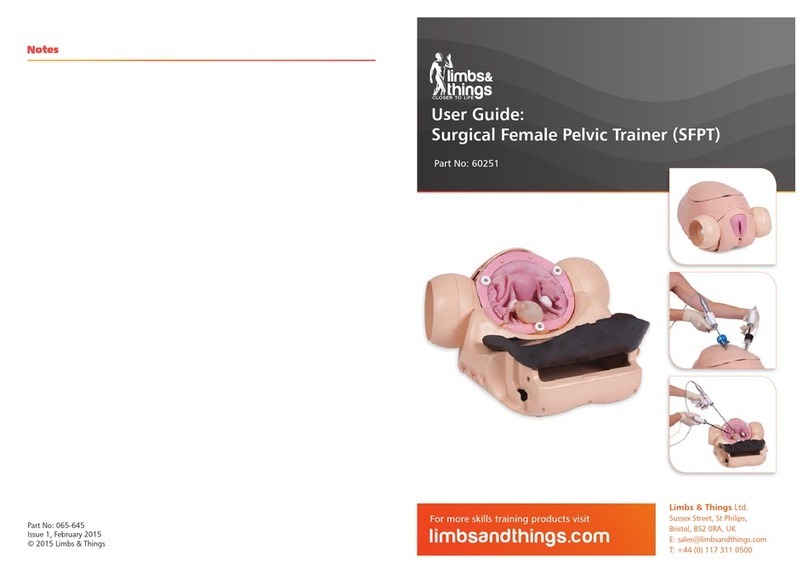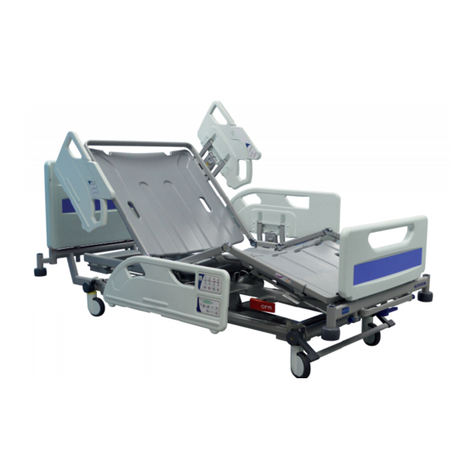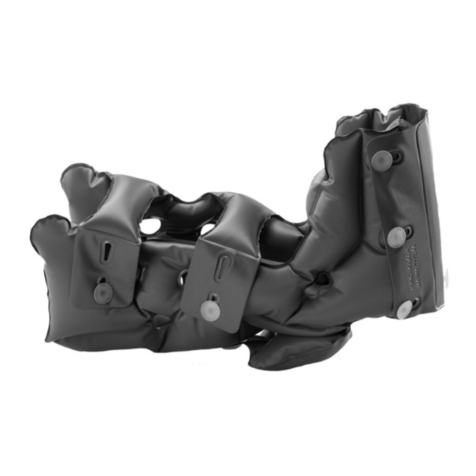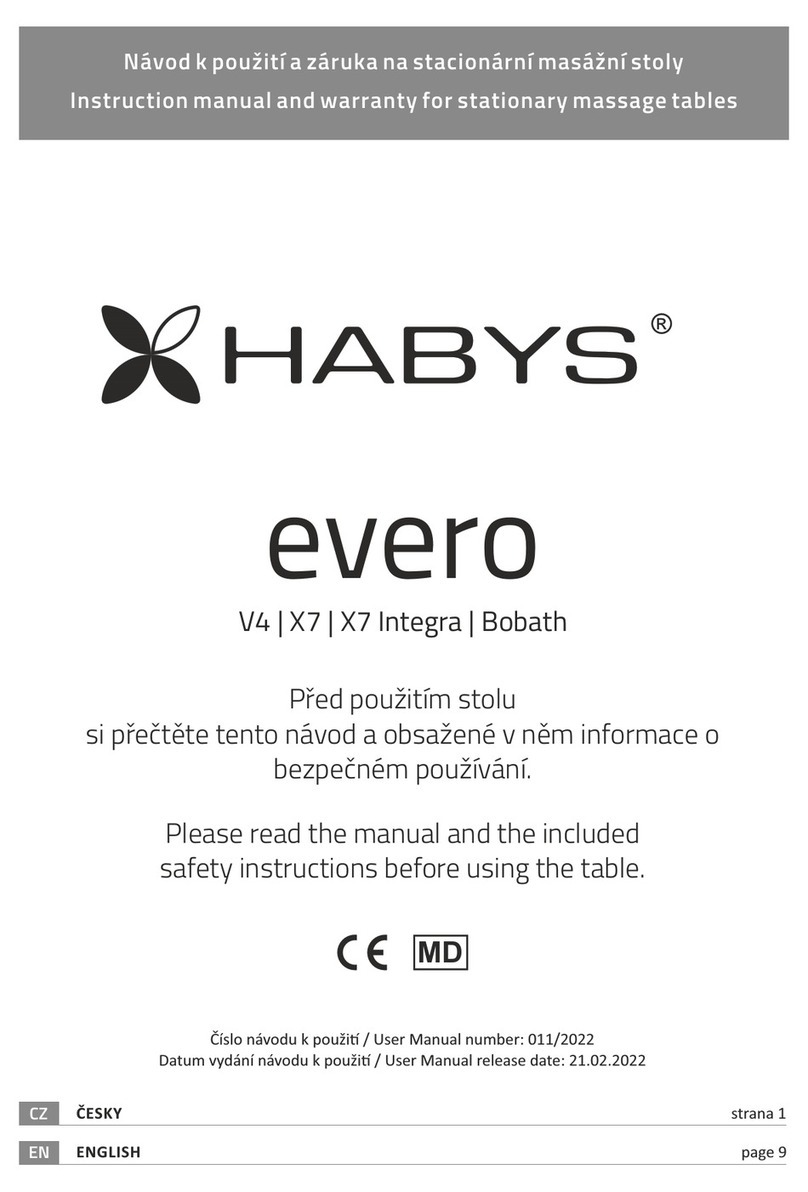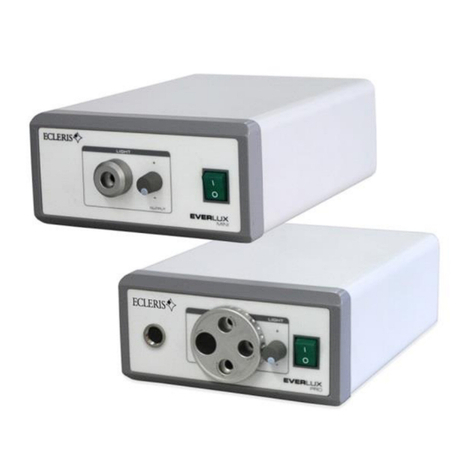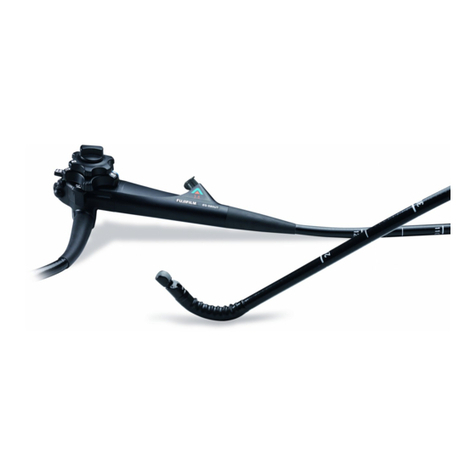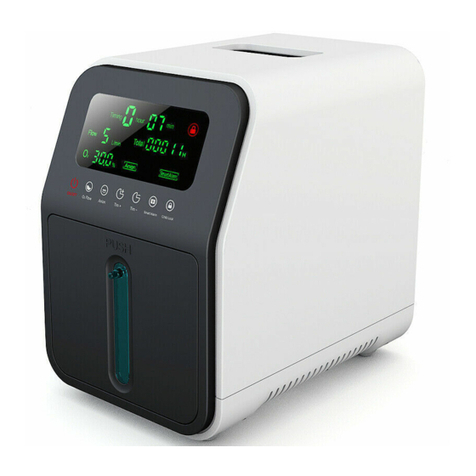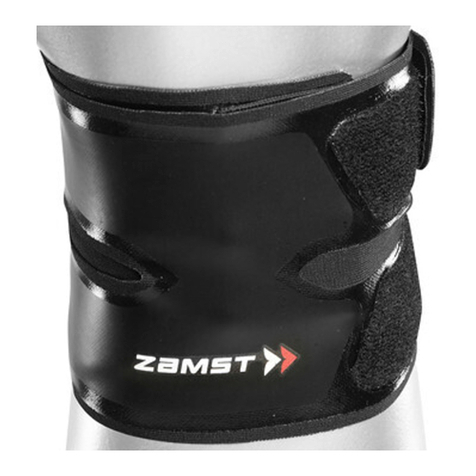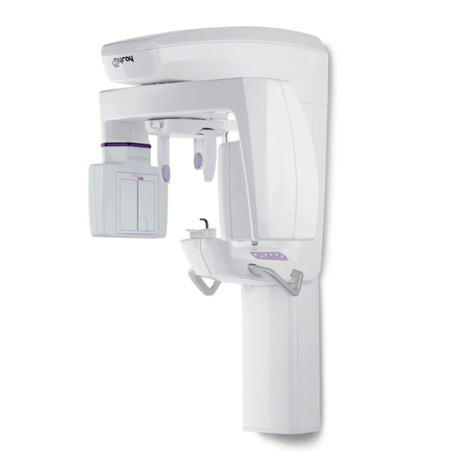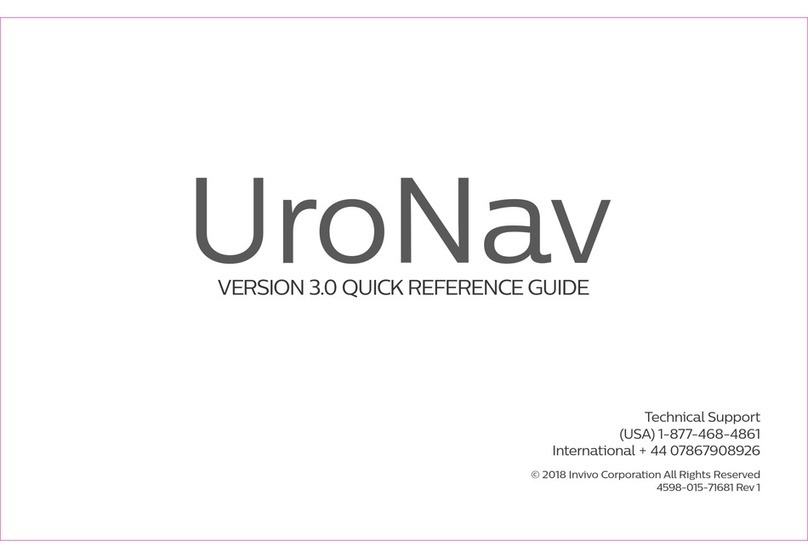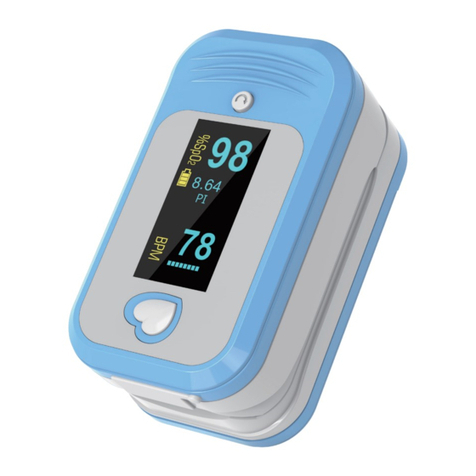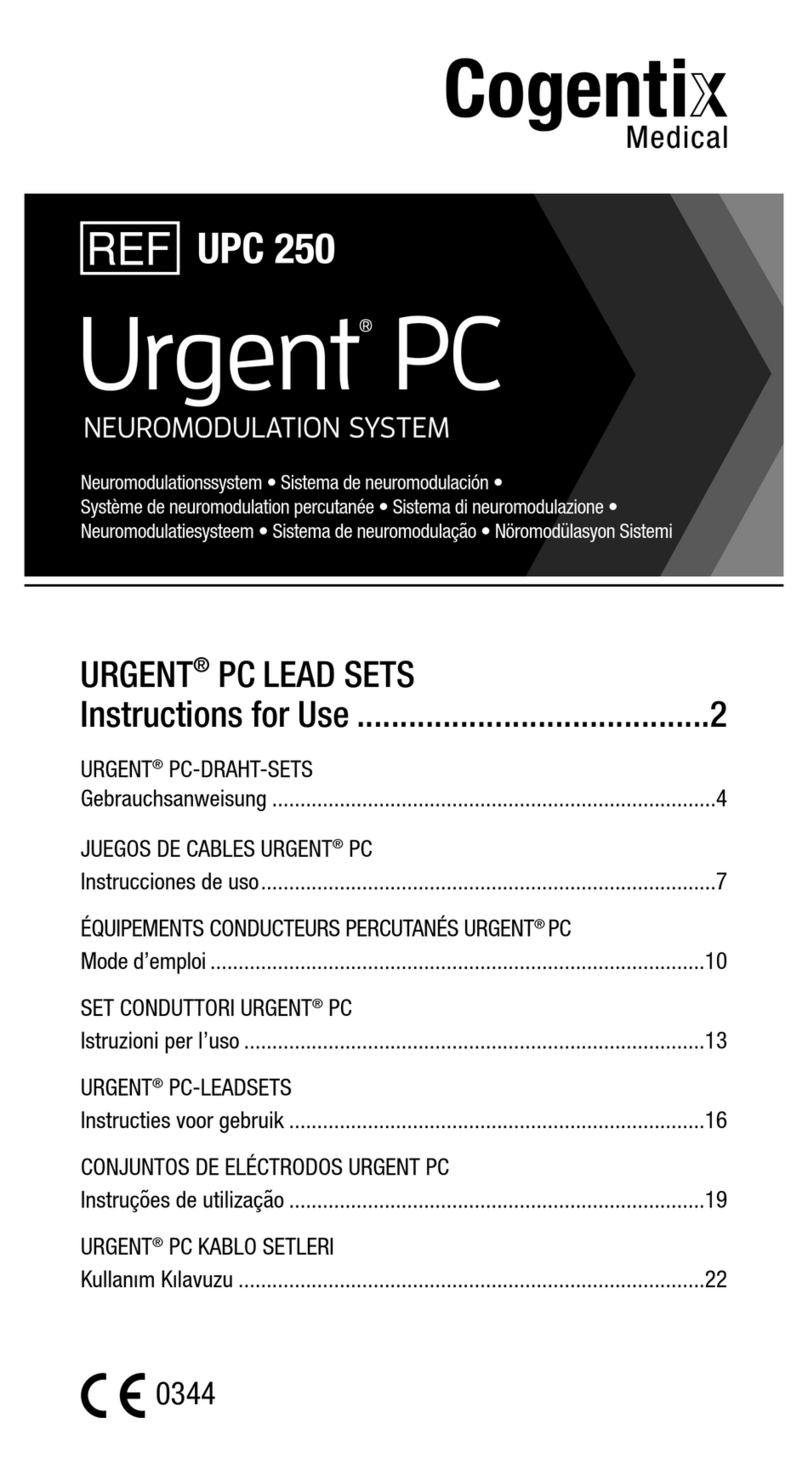Smart MED iDisc Series User manual

User Manual
iDisc Series CPAP

Table of contents
1 Welcome....................................................................................................................................... 1
2 Intended Use................................................................................................................................ 1
3 Contraindications...................................................................................................................... 1
4 Safety Information..................................................................................................................... 2
5 Symbols........................................................................................................................................ 6
6 System Contents........................................................................................................................ 7
7 System Overview....................................................................................................................... 8
8 Navigating the Device Screens........................................................................................... 14
9 Operation.................................................................................................................................... 14
10 Device Alert.............................................................................................................................. 22
11 Troubleshooting..................................................................................................................... 26
12 Cleaning and Maintaining................................................................................................. 28
13 Maintenance.......................................................................................................................... 30
14 Storage and Disposal......................................................................................................... 30
15 Specifications....................................................................................................................... 32
16 EMC Declaration.................................................................................................................. 34

iDisc CPAP Systems User Manual
1
1 Welcome
The IDisc CPAP Systems contain CPAP and APAP Modes. They are both continuous
positive airway pressure during the respiratory cycle devices.
The IDisc CPAP Systems include the following models:
iDisc 20C Fixed pressure & the iDisc 20A Automatic variable pressure range.
Both models can be purchased with a humidifier (Hybird) or without.
Responsibility of the Manufacturing Party
Resvent is responsible for the effects on safety, reliability and performance of this
product, only if:
•All installation operations, expansions, changes, modifications and repairs of
this product are conducted by Resvent authorized personnel.
•All spare parts for repair, accessories, consumable are conducted by Resvent or
the authorized personnel.
•The electrical installation of the relevant room complies with the applicable
national standard and the manual requirements.
•The product is used in accordance with the instruction for use.
IMPORTANT
Read this entire guide before using the device.
2 Intended Use
The iDisc™CPAP system delivers positive airway pressure therapy for the treatment of
Obstructive Sleep Apnea (OSA) in spontaneously breathing patients weighing over
30kg (66lbs). It is intended for use in the home, hospital, or institutional environment.
The system also has the ability for to record a spot check transcutaneous
measurement of oxygen saturation (SpO2) in the blood, using light detection given from
a special probe for adults and pediatrics.
3 Contraindications
When assessing the relative risks and benefits of using this equipment, the clinician
should understand that this device can deliver pressures up to 20 cmH2O. In the event
of certain fault conditions, a maximum pressure of 30 cmH2O is possible. Studies have
shown that the following pre-existing conditions may contraindicate the use of CPAP
therapy for some patients:
•Severe coronary artery disease
•Bullous Lung Disease
•Pathologically Low Blood Pressure
•Bypassed Upper Airway
•Pneumothorax
Caution should be used when prescribing CPAP for susceptible patients such as those
with: cerebral spinal fluid (CSF) leaks, abnormalities of the cribriform plate, prior history
of head trauma, and/or Pneumothorax.
The use of positive airway pressure therapy may be temporarily contraindicated if you
exhibit signs of a sinus or middle ear.

iDisc CPAP Systems User Manual
2
Note: In either case above, it can only be determined by a competent and fully
qualified physician as to whether CPAP therapy through is applicable and safe.
User qualifications
The person operating the device by the instruction in the user’s manual is referred as
the “user”. In contrast, a “patient” is the person receiving the therapy. Always perform
all the operating steps in accordance with the guidelines in this user’s manual.
Users can also receive specified professional training about how to use the device
including all related to accessories from the accredited CPAP dealer or manufacturer.
4 Safety Information
WARNING: Indicate the possibility of injury to the user or patient.
CAUTION: Indicate the possibility of damage to the device.
WARNING:
⚫This manual serves as a reference. The instructions in this manual are not intended
to supersede the health care professional’s instructions regarding the use of the
device.
⚫This device is not intended as a life-supporting device.
⚫A mask should not be used unless the device is turned on, Otherwise, there is
danger of suffocation.
⚫The device must be used only with the masks and accessories recommended by
SmartMed or Resvent. The masks and accessories are validated for use with
Resvent devices.
⚫The exhalation port(s) associated with the mask should never be blocked. The
device is intended to be used with special masks or connectors that have
exhalation ports to allow continuous flow of air out of the mask. When the device is
turned on and functioned properly, new air from the device flushes the exhaled air
out through the mask exhalation port. However, when the device is not operating,
enough fresh air will not be provided through the mask.
⚫If you are using a full face mask (a mask covering both your mouth and your nose),
the mask must be equipped with a safety (entrainment) valve.
⚫When using oxygen with this system, always make sure that the device is turned on
and airflow generated before the oxygen supply is turned on. Always turn the
oxygen supply off before the device is turned off, so that unused oxygen does not
accumulate within the device enclosure and create a risk of fire.
⚫Sources of oxygen must be located more than 1 m from the equipment to avoid the
risk of fire and burns.
⚫Do not connect the device to an unregulated or high pressure oxygen source.
⚫Oxygen must not be used while smoking or in the presence of an open flame.
⚫Do not use the device in the presence of a flammable anesthetic mixture in
combination with oxygen or air, or in the presence of nitrous oxide.
⚫Do not use the device near a source of toxic or harmful vapors.
⚫Do not use this device if the room temperature exceeds 35°C (95°F). If the device is
used at room temperatures warmer, than 35°C (95°F), the temperature of the
airflow may exceed 43°C (109°F). This could cause irritation or injury to your
airway.
⚫The device is not used exceed the specified temperature range.

iDisc CPAP Systems User Manual
3
⚫Do not operate the device in direct sunlight or near a heating appliance because
these conditions can increase the temperature of the air coming out of the device.
⚫Contact your health care professional if symptoms of sleep apnea recur.
⚫If you notice any unexplained changes in the performance of this device, if it is
making unusual or harsh sounds, if it has been dropped or mishandled, if water is
spilled into the enclosure, or if the enclosure is broken, disconnect the power cord
and discontinue use. Contact your home care provider.
⚫Repairs and adjustments must be performed by Resvent authorized service
personnel only. Unauthorized service could cause injury, invalidate the warranty, or
result in costly damage.
⚫Do not use any accessories, detachable parts, and materials not recommended by
Resvent. Incompatible parts or accessories can result in degraded performance.
⚫The Health Industry Manufacturers Association recommends that a minimum
separation of 16cm be maintained between a wireless phone and a pacemaker to
avoid potential interference with the pacemaker.
⚫Use only power cords supplied by Resvent for this device. Use of power cords not
supplied by Resvent may cause overheating or damage to the device and may
result in increased emissions or decreased immunity of the equipment or system.
⚫The device should not be used while stacked or in close approximation to other
non-approved devices.
⚫Use only approved cables and accessories. Misuse may affect EMC performance
and should be avoided.
⚫Inspect the tubing for damage or wear. Discard and replace the tubing as
necessary.
⚫Periodically inspect electrical cords and cables for damage or signs of wear.
Discontinue use and replace if damaged.
⚫To avoid electrical shock, always unplug the power cord from the wall outlet before
cleaning the device. DO NOT immerse the device in any fluids.
⚫Be sure to route the power cord to the outlet in a way that will prevent the cord from
being tripped over or interfered with by chairs or other furniture.
⚫This device is activated when the power cord is connected.
⚫For safe operation when using a humidifier, the humidifier must always be
positioned below the breathing circuit connection at the mask. The humidifier must
be level for proper operation.
⚫Nebulization or humidification can increase the resistance of breathing system
filters and the operator must monitor the breathing system filter frequently for
increased resistance and blockage to ensure the delivery of the therapeutic
pressure.
⚫Please check whether there is water in the device before use. The maximum fill
level is 290 ml.
⚫Failure to use a mask or accessory that minimizes re-breathing of carbon dioxide or
permits spontaneous breathing can cause asphyxiation.
⚫Do not connect breathing tubes or accessories with any humidifier and ventilator
that are not specified for use with these breathing tubes or accessories.
⚫Do not cover or heat the breathing tube with anything influent the patient end
temperature.
⚫Do not use this device outside the specified ambient temperature range or humidity
range. The humidity performance of the device can be compromised when used
outside the specified ambient temperature range or humidity range.
⚫No modification of this equipment is allowed.
⚫Parts of the equipment are not serviced or maintained while in use with the patient.
⚫The PATIENT is an intended OPERATOR.

iDisc CPAP Systems User Manual
4
The Patient can safely use therapy functions of the equipment and this equipment
shall not be serviced or maintained while in use with the patient.
⚫Please first check the breathing tube is connected correctly and laid out carefully so
it does not pose as a strangulation risk.
⚫Do not pull or stretch the tubing. This could result in circuit leaks.
⚫If the device is used by multiple persons (such as rental devices), a low-resistance,
main flow bacteria filter should be installed in-line between the device and the
circuit tubing to prevent contamination.
⚫Allow the humidifier heater plate and water to cool down for approximately 15
minutes before removing the water tank. A burn may result from: touching the
heater plate, coming in contact with the heated water, or touching the tank pan.
⚫Do not strike the battery pack with a hammer, step on the battery pack or otherwise
subject it to strong impacts or shocks.
⚫Do not expose the battery pack to water or allow the battery pack to get wet.
⚫Do not place the battery pack on or near fires, stoves or other high-temperature
locations.
⚫Only charge the battery pack with the power adapter supplied by Resvent.
CAUTION:
⚫Medical electrical equipment needs special precautions regarding EMC and needs
to be installed according to EMC information, Contact your home care provider
regarding EMC installation information.
⚫Mobile RF communications equipment can affect medical electrical equipment.
⚫Pins of connectors marked with the ESD warning symbol shall not be touched and
connections shall not be made without special precautions. Precautionary
procedures include methods to prevent build-up of electrostatic charge (e.g., air
conditioning, humidification, conductive floor coverings, non-synthetic clothing),
discharging one’s body to the frame of the equipment or system or to earth. It is
recommended that all individuals that will handle this device understand these
precautionary procedures at a minimum as part of their training.
⚫Condensation may damage the device. If this device has been exposed to either
very hot or very cold temperatures, allow it to adjust to room temperature (operating
temperature) before starting therapy. Do not operate the device outside of the
operating temperature range shown in the Specifications.
⚫Do not use extension cords with this device.
⚫Make sure the filter area on the side of the device is not blocked by bedding,
curtains, or other items. Air must flow freely around the device for the system to
work properly.
⚫Make sure the gas intake port on the side of the device is not blocked by bedding,
curtains, or other items. Air must flow freely around the device for the system to
work properly.
⚫Do not place the device directly onto carpet, fabric, or other flammable materials.
⚫Do not place the device in or on any container that can collect or hold water.
⚫A properly installed, undamaged filter is required for proper operation.
⚫Tobacco smoke may cause tar build-up within the device, which may result in the
device malfunctioning.
⚫Dirty inlet filters may cause high operating temperatures that may affect device
performance. Regularly examine the inlet filters as needed for integrity and
cleanliness.

iDisc CPAP Systems User Manual
5
⚫Always ensure that the DC power cord securely fits into your therapy device prior to
use. Contact your home care provider or Resvent to determine if you have the
appropriate DC cord for your specific therapy device.
⚫When DC power is obtained from a vehicle battery, the device should not be used
while the vehicle’s engine is running. This may cause damage to the device.
⚫Only use a Resvent DC Power Cord and Adapter Cable. Use of any other system
may cause damage to the device.
⚫When change the pressure setting, please consult your doctor.
⚫Do not position next to a curtain that blocks the flow of cooling air, thereby causing
the equipment to overheat.
⚫Do not block the gas INTAKE PORT, thereby interfering with therapy.
⚫Please follow the local regulation when disposal the device
⚫The proper placement and positioning of the MASK on the face is critical to the
consistent operation of this equipment.
⚫Please check that the compatibility of the equipment and all of the parts and
accessories used to connect to the patient before use.
⚫Ensure that the therapeutic pressure settings were determined for the patient
individually with the configuration of the equipment to be used, including
accessories.
⚫For multiple patients use, please use personal breathing tube and mask, do not use
other.
⚫You should position the device far away your pets, pests or children when you use
the device in home environment.
⚫In case you feel comfortless when you contact the device. You shall stop to use the
device and contact your supplier immediately. Because it may cause allergic
reactions.
⚫Please periodically reassess the setting(s) of the therapy for effectiveness.
⚫Never install a wet filter into the device. You must ensure sufficient drying time for
the cleaned filter.
⚫If you need to measure the oxygen saturation in the system, please refer the Wrist
Pulse Oximeter User Manual for the oximeter adapter.
⚫Do not expose the battery pack to extreme temperatures (see the Specifications
section). If the battery pack becomes very hot or very cold, allow it to come to room
temperature before using.
⚫There are no user-serviceable parts inside of the battery pack; therefore, do not
attempt to disassemble or repair it.
Empty the water tank before packing or moving the device!

iDisc CPAP Systems User Manual
6
5 Symbols
The following symbols may appear on the device, power supply and accessories.
Symbol
Definition
Manufacturer.
Date of Manufacture.
Serial number.
DC Power.
Temperature limitations at transport and storage.
Humidity limitations at transport and storage.
Atmospheric pressure at transport and storage.
Follow instruction for use. This label on the device points the
user to the operator’s manual for complete information. In the
operator’s manual, this symbol cross-references the label.
The product bears CE mark indicating its conformity with the
provisions of the Council Directive 93/42/EEC concerning
medical devices and fulfils the essential requirements of Annex
I of this directive.
European Authorized Representative.
Dispose according to Council Directive 2012/19/EU or WEEE
(Waste Electrical and Electronic Equipment).
Indicates the degree of protection against electric shock
according to IEC 60601-1. Class II devices have double or
reinforced insulation, as they have no provision for protective
grounding.
Indicates the degree of protection provided by enclosure
according to IEC 60601-1.
Type BF Applied part (classification of medical electrical
equipment, type B, as specified by IEC 60601-1).
The device is not suitable for use in MRI environment.
Respiratory air humidifier is heated. Do not touch the element.

iDisc CPAP Systems User Manual
7
Therapy On/Off Button (Starts and stops the airflow for
therapy).
This way up at transport and storage.
Fragile, handle with care.
Keep dry at transport and storage.
Stacking limitations.
Recyclable materials.
6 System Contents
Your CPAP system may include the following items:
⚫Device
⚫Humidifier
⚫Flexible Tube: 19 mm or 15 mm tube
⚫Travel Bag
⚫User Manual
⚫Power Adapter
⚫Power Cord
⚫Micro SD Card or modem
⚫Battery Pack (optional)
⚫Tube Adaptor (optional)
NOTE: If any of these items are missing, please contact your home care provider.

iDisc CPAP Systems User Manual
8
7 System Overview
#
Device Feature
Description
1
Therapy On/Off Key
Starts and stops the airflow for therapy.
2
Ramp Key
Activate the ramp feature during therapy.
3
LCD Display Screen
This is the User interface for the therapy device.
4
Humidifier Lid Lock
Press the lock to open the humidifier lid.
5
Air Outlet Port
Connect the tubing here.
6
Humidifier
The heated humidifier.
7
Air Inlet Port
Inlet for room air.
8
Power Inlet
Connect the power cord here.
9
Maximum Fill Lines
The fill lines indicates the maximum water level for
safe operation.
10
Humidifier Release
Button
Press the button to apart the device and humidifier.
7.1 Docking the Device
Complete the following steps to dock the device to the humidifier:
1. Line up the back of the device to the front of the heated humidifier.
2. Make sure the air outlet port on the device lines up with the air inlet port on the
humidifier.
3. Slide the two units together until they click into place.

iDisc CPAP Systems User Manual
9
4. Make sure that the therapy device and the humidifier are completely seated against
each other.
5. Place the device and heated humidifier (with an empty water tank) on a firm, flat
surface lower than your sleeping position.
Note:
⚫When positioning the device, make sure that the power cable is accessible
because removing power is the only way to power down the device.
⚫Make sure the device is away from any heating or cooling equipment (e.g., forced
air vents, radiators, air conditioners).
CAUTION:
⚫Make sure the filter area on the side of the device is not blocked by bedding,
curtains, or other items. Air must flow freely around the device for the system to
work properly.
⚫Do not move the humidifier while the water tank has water in it.
⚫Do not place the device directly onto carpet, fabric, or other flammable materials.
⚫Do not place the device in or on any container that can collect or hold water.
7.2 Connecting AC Power
Complete the following steps to operate the device using AC power:
1. Plug the socket end of the AC power cord (included) into the power supply (also
included).
2. Plug the pronged end of the AC power cord into an electrical outlet that is not controlled
by a wall switch.
3. Plug the power supply cord’s connector into the power inlet on the side of the device.

iDisc CPAP Systems User Manual
10
4. Verify that the plug at the side of the device, at the power supply, and at the
electrical outlet are fully inserted.
WARNING:
⚫During use if the power cord is disconnected or a power failure, the device alarm
will sound. Please stop using it and check the power status.
⚫Please do not touch the connector if it is broken.
⚫Please avoid arcing, wiggling, or dropping the power supply on hard surfaces.
⚫Please periodically inspect electrical cords and cables for damage or signs of wear
and discontinue use and replace if damaged.
⚫Never place the power cord around your neck.
⚫Do not use any small parts to fix power cord in position as they might be
accidentally swallowed.
7.3 Connecting the Breathing Circuit
To use the system, you need the following accessories in order to assemble the
recommended breathing circuit:
⚫Mask interface (nasal mask or full face mask) with integrated exhalation port.
⚫Resvent flexible tubing.
To connect your breathing circuit to the device, please follow the below steps:
1. Open the air inlet port lid and press the tubing into place over the air outlet port.
2. Connect the tubing to the mask. For specific parameters and the correct use of the
method, please refer to the breathing hose manual.
WARNING: Do not pull or stretch the tubing, this could result in circuit leaks.
Inspect the tubing for damage or wear. Discard and replace the tubing as necessary.
3. Attach the headgear to the mask if necessary. For specific parameters and the correct
use of the method, please refer to the mask manual.
WARNING:
⚫If you are using a full face mask (a mask covering both your mouth and your
nose), the mask must be equipped with a safety (entrainment) valve.

iDisc CPAP Systems User Manual
11
⚫If multiple users share the same equipment, use low-resistance and bacteria-
filtered cotton between the equipment and the tube.
⚫If necessary, place a bacterial filter in the air outlet of the unit and connect the
tube. The use of bacterial filter cotton may affect the equipment efficiency
however, the device will still function to specification.
⚫Never place the long tube or hose around the neck.
⚫Do not use any small parts to fix the respiration hose in position as they might be
accidentally swallowed.
⚫Do not squash the hose.
7.4 Water-filling Operation
1. Press the humidifier lid lock, lift up on the humidifier lid and swing completely open.
2. Remove the water tank from the humidifier base.
3. Fill the water tank with water up to the maximum fill line.
4. Install the water tank into the humidifier.
5. Close the humidifier lip until it clicks shut.
❶The fill line indicates 1/3 water level for safe operation.

iDisc CPAP Systems User Manual
12
❷The fill line indicates 2/3 water level for safe operation.
❸The fill line indicates the maximum water level for safe operation.
CAUTION:
⚫Use only room temperature distilled water or purified water.
⚫Do not fill the water tank above the maximum fill line. If the water tank is overfilled,
water may leak into the therapy device, humidifier, or onto your furniture. Damage
to the humidifier or therapy device may occur.
⚫Empty the water tank when the device is not in use.
7.5 Using the Battery Pack
The device supports power via the iDisc battery pack. Depending on the device
settings, mask leak and environmental conditions, a fully charged battery pack typically
lasts up to 10 hours.
#
Device Feature
Description
1
Battery Pack Lock
Button
Push the button to lock/unlock the device and battery
pack.
2
Power Inlet
Connect the power cord.
3
Battery Capacity
Indicators
The LED lights indicate the different capacity of
battery: The capacity of the battery is 75%-100%.
The capacity of the battery is 50%-75%.
The capacity of the battery is 25%-50%.
The capacity of the battery is 0%-25%.
4
Indicator Button
Press the button to light up the LED Indicators.
5
Tube Adaptor
Connect the device and tube while using the battery
pack.

iDisc CPAP Systems User Manual
13
Attaching the Battery Pack to the Device
Please remove the device from the humidifier dock before attaching the battery pack.
Follow the below steps:
1. The device sits on top of the battery. Line up the battery and device using the tube
port as a guide.
2. Press down the device to ensure the connection is tight.
3. Slide the lock button across to lock the battery pack in securely.
Connecting the Breathing Circuit
When using the battery pack, one end of the breathing circuit must attach to the air
outlet port of the device via the ‘iHush’ tube adaptor. Follow the below steps:
1. Plug the ‘iHush’ tube adapter into the air outlet port of the device.
2. Connect one end of the breathing tube to the tube adapter, and ensure all
connections are tight to avoid air leaks.

iDisc CPAP Systems User Manual
14
8 Navigating the Device Screens
The User Interface (UI) on this device allows you to adjust the device settings and view
information about your therapy. The device screen supports touch operations. You can
operate the device directly on the screen.
Note: The screens shown throughout this manual are examples for reference only.
Actual screens may vary based upon device model and provider settings.
9 Operation
This chapter describes basic operation and precautions associated with this device.
Each time you turn on the device, it will automatically run set by the user.
9.1 Starting the Device
1. Ensure power is supplied to the device. The first screen to display will be the brand
logo, within 5 second followed by the patient standby screen (See Figure 1).
Note: Boot alarm should be “beep”. If this doesn’t happen, please contact the
supplier for inspection.
2. Put on your mask assembly. Refer to the instructions supplied with the mask.
3. Pressthe Therapy On/Off key on top of the device to turn on airflow andbegin therapy.
The screen will display to patient therapy clean interface (see Figure 2).
4. Adjust the mask and headgear until the air leak stops.
5. If you are using the device in a bed with a headboard, try placing the tubing over the
headboard. This may reduce tension on the mask.
6. Press the Therapy On/Off key again to turn off therapy.
Note:
1. When any power interruption (e.g., blackout) happens during therapy, the device will
resume therapy mode if the power is restored within 60 minutes.
2. Please keep away from incense and candles avoiding catching fire during use.
9.2 Patient Menu Navigation Settings
Patient Menu Navigation Setting including Standby interface shortcut operation、
Therapy interface shortcut operation、Comfort Parameters setting interface、System
setting interface.
9.2.1 Patient Standby Interface
The Patient Standby Interface displays setup menus for the system main features,
and the icons to indicate the current enabled features.

iDisc CPAP Systems User Manual
15
Figure1 Patient Standby Interface
#
Feature
Description
1
Mode
Displays the current therapy mode.
2
Enabled features
Depending on setup, certain enabled therapy features
will display here such as clock alarm etc.
3
Time
Displays the current time.
4
Patient Sleep Quality
Report
Displays the patient sleep quality report. The options
for period of the report can be shown as: Daily (recent
6 days) / 7 days / 14 days / 1 month / 3 months / 6
months / 1 year.
5
Humidity
Option to allow the operator to adjust the humidity level.
Option: Auto / OFF / 1-8 Default: 3
Note: The humidity level only can be set when the
water in humidifier exceeds the minimum water level for
safe operation.
6
Mask fit
Mask fit feature blows a higher amount of air as a
therapy simulation and allows the user to adjust the
mask straps to minimize leak.
7
Comfort
Press to enter Comfort setting menu.
8
Setting
Press to enter detailed Patient System Setting menu.
9
Alarm Message
Displays the alarm message log.

iDisc CPAP Systems User Manual
16
9.2.2 Patient Therapy Interface
When the therapy starts, the screen will switch to the Patient Therapy Interface, which
displays the therapy parameters monitoring during therapy (See Figure2). The
displayed parameters depend on the current therapy mode.
Figure2 Patient Therapy Interface
#
Description
1
The current therapy mode.
2
Alarm message log.
3
Humidity adjustment shortcut key and humidity level.
Note: The humidity level is available when the humidity function is on.
4
Breathing animated graphic.
5
The current therapy pressure being generated.
6
The therapy pressure settings programmed for the patient.
7
Ramp time dynamic diagram.
Note: Only available when the Ramp function is on.
8
Work status icon bar.

iDisc CPAP Systems User Manual
17
9.2.3 Patient Comfort Setting
Press key in the Patient Standby interface to enter Patient Comfort Setting
Interface.
Figure3 Patient Comfort Setting Interface
Icon
Text
Description
Preheat
Turn Preheat function on or off. When the Preheat is on,
the humidifier starts preheating in the standby mode and
the maximum preheating time is 30 minutes. In the
therapy mode, the preheating stops.
Option: ON / OFF Default: OFF
Note:
1. If the humidifier water level below the limit, Preheat
function will be turned off automatically.
2. If humidifier function is turned off, Preheat function will
be disable.
P Ramp
Set the starting pressure of Ramp.
Setting Range: 3 cmH2O-Setting pressure, 0.5 cmH2O
increments.
Default: 4 cmH2O
Ramp Time
Set the increase time from Ramp pressure to the setting
therapy pressure.
Option: 0-60 mins, 5 mins increments

iDisc CPAP Systems User Manual
18
Icon
Text
Description
Default: 15 mins
Note: if Ramp Time sets to 0 min, Ramp function will be
off.
Auto Ramp
Turn Auto Ramp function on or off.
When Auto Ramp is on and a sleep state has been
identified, the device will ramp to the set therapy
pressures. This will also happen after 45 mins if sleep is
not detected.
Option: ON / OFF Default: OFF
Auto Start
Turn Auto Start function on or off.
When the Auto Start function is on, the system will start
therapy automatically once it detects breathing through
the connected mask. If the mask is removed for more
than 5 seconds, the therapy mode will automatically stop.
Option: ON / OFF Default: ON
IPR
Set IPR (Intelligent Pressure Release) level. This is the
level of pressure that is backed off on exhale to make it
more natural for the patient to breathe.
Option: OFF / 1-3 Default: 2
Tube Type
Set the Tube type.
Option: 15 mm / 19 mm Default: 15 mm
9.2.4 Patient System Setting
Press key in the Patient Standby interface to enter Patient Setting interface.
Table of contents
Other Smart MED Medical Equipment manuals
